A 30-Year Probability Map for Oil Spill Trajectories in the Barents Sea to Assess Potential Environmental and Socio-Economic Threats
Abstract
:1. Introduction
2. Resources of the Barents Sea
2.1. Environment
2.1.1. Protected Areas
2.1.2. Marine Resources
2.2. Economic Activities
2.2.1. Marine Resources
2.2.2. Transportation
2.2.3. Oil and Gas Industry
2.3. Local Communities
2.3.1. Indigenous Peoples
2.3.2. Regional Development
3. Location, Methods and Oil Characteristics
3.1. Location
3.2. Methods
3.3. Oil Characteristics
4. Results and Discussion
4.1. Oil Behaviour and Spill Response Efficiency
4.1.1. Oil Types
4.1.2. Summer
4.1.3. Autumn and Winter
4.1.4. Spring
5. Conclusions
Author Contributions
Funding
Informed Consent Statement
Acknowledgments
Conflicts of Interest
References
- Wells, P.G. The iconic Torrey Canyon oil spill of 1967—Marking its legacy. Mar. Pollut. Bull. 2017, 115, 1–2. [Google Scholar] [CrossRef]
- ITOPF, The International Tanker Owners Pollution Federation Limited. Oil Tanker Spill Statistics 2018. 2019. Available online: http://www.itopf.org/fileadmin/data/Documents/Company_Lit/Oil_Spill_Stats_2019.pdf (accessed on 15 October 2019).
- Wenning, R.J.; Robinson, H.; Bock, M.; Rempel-Hester, M.A.; Gardiner, W. Current practices and knowledge supporting oil spill risk assessment in the Arctic. Mar. Environ. Res. 2018, 141, 289–304. [Google Scholar] [CrossRef]
- Pavlov, V. Arctic Marine Oil Spill Response Methods: Environmental Challenges and Technological Limitations. In Physics and Chemistry of the Arctic Atmosphere; Pongrácz, E., Pavlov, V., Hänninen, N., Eds.; Springer: Cham, Switzerland, 2020; pp. 213–248. [Google Scholar]
- Afenyo, M.; Khan, F.; Veitch, B.; Yang, M. Modeling oil weathering and transport in sea ice. Mar. Pollut. Bull. 2016, 107, 206–215. [Google Scholar] [CrossRef]
- Oil Change International (OCI), Greenpeace. Frozen Future. The Gaps in Shell’s Arctic Spill Response. 2015. Available online: http://priceofoil.org/content/uploads/2015/04/2015-The-gaps-in-Shells-Arctic-spill-response.pdf (accessed on 2 January 2016).
- Panichkin, I. Arctic Oil and Gas Resource Development: Current Situation and Prospects. Available online: https://russiancouncil.ru/en/arcticoil (accessed on 19 November 2020).
- Parviainen, T.; Lehikoinen, A.; Kuikka, S.; Haapasaari, P. Risk frames and multiple ways of knowing: Coping with ambiguity in oil spill risk governance in the Norwegian Barents Sea. Environ. Sci. Policy 2019, 98, 95–111. [Google Scholar] [CrossRef]
- Arnarsson, S.; Dam, K.; Justus, D.; Latola, K.; Łuszczuk, M.; Sander, G.; Scheepstra, A.; Stępień, A.; Strahlendorff, M. Strategic Environmental Impact Assessment of Development of the Arctic. 2014. Available online: http://library.arcticportal.org/1792/1/SADA_report.pdf (accessed on 15 April 2017).
- Kirby, M.F.; Law, R.J. Accidental Spills at Sea—Risk, Impact, Mitigation and the Need for co-Ordinated Post-Incident Monitoring. Mar. Pollut. Bull. 2010, 60, 797–803. [Google Scholar] [CrossRef]
- Borch, O.J.; Andreassen, N.; Marchenko, N.; Ingimundarson, V.; Gunnarsdóttir, H.; Ludin, I.; Petrov, S.; Jakobsen, U.; Dali, B. Maritime Activity in the High North—Current and Estimated Level Up to 2025. MARPART Project Report 1. 2016. Available online: https://brage.bibsys.no/xmlui/bitstream/handle/11250/2413456/Utredning72016.pdf?sequence=5&isAllowed=y (accessed on 7 September 2017).
- Kulakov, M.; Pogrebov, V.B.; Timofeyev, S.F.; Chernva, N.V.; Kiyko, O.A. Chapter 29. Ecosystem of the Barents and Kara Seas, Coastal Segment (22, P). In The Sea; Robinson, A.R., Brink, K.H., Eds.; President and Fellows of Harvard College: Cambridge, MA, USA, 2004; pp. 1135–1172. [Google Scholar]
- Keramea, P.; Spanoudaki, K.; Zodiatis, G.; Gikas, G.; Sylaios, G. Oil Spill Modeling: A Critical Review on Current Trends, Perspectives, and Challenges. J. Mar. Sci. Eng. 2021, 9, 181. [Google Scholar] [CrossRef]
- Alves, T.M.; Kokinou, E.; Zodiatis, G. A three-step model to assess shoreline and offshore susceptibility to oil spills: The South Aegean (Crete) as an analogue for confined marine basins. Mar. Pollut. Bull. 2014, 86, 443–457. [Google Scholar] [CrossRef]
- Alves, T.M.; Kokinou, E.; Zodiatis, G.; Lardner, R.; Panagiotakis, C.; Radhakrishnan, H. Modelling of oil spills in confined maritime basins: The case for early response in the Eastern Mediterranean Sea. Environ. Pollut. 2015, 206, 390–399. [Google Scholar] [CrossRef] [Green Version]
- Alves, T.M.; Kokinou, E.; Zodiatis, G.; Lardner, R. Hindcast, GIS and susceptibility modelling to assist oil spill clean-up and mitigation on the southern coast of Cyprus (Eastern Mediterranean). Deep. Sea Res. Part II Top. Stud. Oceanogr. 2016, 133, 159–175. [Google Scholar] [CrossRef]
- Adler, E.; Inbar, M. Shoreline sensitivity to oil spills, the Mediterranean coast of Israel: Assessment and analysis. Ocean Coast. Manag. 2007, 50, 24–34. [Google Scholar] [CrossRef]
- Beegle-Krause, C.J.; Simmons, H.; McPhee, M.; Lundmark Daae, R.; Reed, M. Literature Review: Fate of Dispersed Oil Under Ice. Final Report 1.4. 2013. Available online: http://www.arcticresponsetechnology.org/wp-content/uploads/2014/02/Report-1.4-Fate-of-Dispersed-Oil-under-Ice.pdf. (accessed on 9 December 2015).
- Dobrovolsky, A.D.; Zalogin, B.C. USSR Seas (Mopя CCCP). 1982. Available online: http://ashipunov.info/shipunov/school/books/dobrovolskij1982_morja_sssr.pdf (accessed on 7 September 2017).
- Emergency Prevention, Preparedness and Response (EPPR) Working Group of the Arctic Council. Guide to Oil Spill Response in Snow and Ice Conditions. 2015. Available online: https://oaarchive.arctic-council.org/handle/11374/403 (accessed on 2 January 2016).
- Emergency Prevention, Preparedness and Response (EPPR) Working Group of the Arctic Council. Reykjavik, Iceland, 2–3 December 2015. Impact of Metocean Conditions on Oil Spill Response Viability in the Arctic (Previ-ously named Circumpolar Oil Spill Response GAP Analysis). 2015. Available online: http://arctic-council.org/eppr/wp-content/uploads/2015/06/2015_11_16_COSRVA_Analysis_Update.pdf (accessed on 30 December 2015).
- Fingas, M. Handbook of Oil Spill Science and Technology; John Wiley & Sons: Hoboken, NJ, USA, 2015; p. 728. [Google Scholar]
- Matishov, G.; Golubeva, N.; Titova, G.; Sydnes, A.; Voegele, B. Barents Sea, GIWA Regional Assessment 11. 2004. Available online: http://www.unep.org/dewa/giwa/areas/reports/r11/giwa_regional_assessment_11.pdf (accessed on 3 February 2017).
- Sukhotin, A.; Denisenko, S.; Galaktionov, K. Pechora Sea ecosystems: Current state and future challenges. Polar Biol. 2019, 42, 1631–1645. [Google Scholar] [CrossRef]
- Vorobiev, U.L.; Akimov, V.A.; Sokolov, U.I. Пpeдyпpeждeниe и Ликвидaция Aвapийныx Paзливoв Нeφти и Нeφтeпpoдyктoв (Oil and oil Products Spill Prevention and Response); In-Oktavo: Moscow, Russia, 2005; p. 368. [Google Scholar]
- RIA. Specially Protected Areas in the Russian Arctic. 2011. Available online: https://ria.ru/arctic_mm/20111226/527007298.html (accessed on 7 September 2017).
- Conservation of Arctic Flora and Fauna (CAFF). Protected Areas of the Arctic: Conserving a Full Range of Values; CAFF: Ottawa, ON, Canada, 2002. [Google Scholar]
- Pasvik State Nature Reserve (PSNR). Rare Species. 2019. Available online: http://www.pasvik51.ru/index.php/en/nature/rare-species (accessed on 12 November 2019).
- UNEP-WCMC and IUCN. Protected Planet: The World Database on Protected Areas (WDPA). 2019. Available online: https://www.protectedplanet.net (accessed on 23 September 2019).
- Mecklenburg, C.W.; Lynghammar, A.; Johannesen, E.; Byrkjedal, I.; Christiansen, J.S.; Dolgov, A.V.; Karamushko, O.V.; Mecklenburg, T.A.; Møller, P.R.; Steinke, D.; et al. Marine Fishes of the Arctic Region; Conservation of Arctic Flora and Fauna: Akureyri, Iceland, 2018; ISBN 978-9935-431-69-1. [Google Scholar]
- Durif, C. Lumpfish. 2016. Available online: https://www.hi.no/en/hi/temasider/species/lumpfish (accessed on 15 October 2019).
- Skaret, G. Polar Cod. 2013. Available online: https://www.hi.no/en/hi/temasider/species/polar-cod (accessed on 15 October 2019).
- FishSource. Atlantic Cod: Barents Sea. 2019. Available online: https://www.fishsource.org/stock_page/1727 (accessed on 15 October 2019).
- World Wildlife Fund (WWF). Arctic Geographical Information System. 2013. Available online: http://wwfarcticmaps.org/ (accessed on 11 June 2019).
- Corbett, J.J.; Lack, D.A.; Winebrake, J.J.; Harder, S.; Silberman, J.A.; Gold, M. Arctic shipping emissions inventories and future scenarios. Atmos. Chem. Phys. Discuss. 2010, 10, 9689–9704. [Google Scholar] [CrossRef] [Green Version]
- Mjelde, A.; Martinsen, K.; Eide, M.; Endresen, Ø. Environmental accounting for Arctic shipping—A framework building on ship tracking data from satellites. Mar. Pollut. Bull. 2014, 87, 22–28. [Google Scholar] [CrossRef] [PubMed]
- Protection of the Arctic Marine Environment (PAME). The Increase in Arctic Shipping. 2020. Available online: https://pame.is/document-library/pame-reports-new/pame-ministerial-deliverables/2021-12th-arctic-council-ministerial-meeting-reykjavik-iceland/793-assr-1-the-increase-in-arctic-shipping-2013-2019/file (accessed on 5 July 2021).
- Stobberup, K.; Erzini, K.; Lam, V.; Pauly, D. Fisheries Management and the Arctic in the Context of Climate Change. 2015. Available online: http://www.europarl.europa.eu/RegData/Etudes/STUD/2015/563380/IPOL_STU(2015)563380_EN.pdf (accessed on 3 September 2019).
- Bogstad, B. Cod—Northeast Arctic. 2017. Available online: https://www.hi.no/en/hi/temasider/species/cod--northeast-arctic (accessed on 15 October 2019).
- Carroll, J.; Vikebø, F.; Howell, D.; Broch, O.J.; Nepstad, R.; Augustine, S.; Skeie, G.M.; Bast, R.; Juselius, J. Assessing impacts of simulated oil spills on the Northeast Arctic cod fishery. Mar. Pollut. Bull. 2018, 126, 63–73. [Google Scholar] [CrossRef]
- Ocean Trawlers. Decision for the 2016 Barents Sea Quota. 2015. Available online: http://www.oceantrawlers.com/decision-for-the-2016-quota-for-barents-sea/ (accessed on 7 September 2017).
- Ocean Trawlers. Decision for the 2017 Barents Sea Quota. 2016. Available online: http://www.oceantrawlers.com/decision-for-the-2017-barents-sea-quota/ (accessed on 7 September 2017).
- Staalesen, A. Less Cod in Barents Sea Must be Followed by Reduced Quotas, Researchers Say. 2017. Available online: https://thebarentsobserver.com/en/ecology/2017/06/less-cod-barents-sea-must-be-followed-reduced-quotas-researchers-say (accessed on 7 September 2017).
- Bambulyak, A.; Frantzen, B.; Rautio, R. Oil Transport from the Russian Part of the Barents Region. 2015 Status Report; The Norwegian Barents Secretariat and Akvaplan-niva: Kirkenes, Norway, 2015; 105p. [Google Scholar]
- Chernyaev, A.; Belova, L.; Prokhorova, N.; Pupova, Y. Waters of Russia; AQUA-PRESS: Rezh, Russia, 2000; pp. 92–94. [Google Scholar]
- VEO Russia. Scientific Works of VEO Russia (Tpyды BЭC Poccии). 2014. Available online: http://veorus.ru/upload/iblock/dc9/182_veor.pdf (accessed on 30 November 2017).
- Matishov, G.G.; Brekhuntsov, A.M.; Dzhenyuk, S.L. Studies of the Kara Sea in the Modern Stage of Development of the Russian Arctic. 2013. Available online: http://eng.arctica-ac.ru/docs/1(9)/004_011_ARKTIKA_1(9)_03_2013.pdf (accessed on 7 September 2017).
- Ports. Norway. Barents Sea Ports. 2017. Available online: http://ports.com/sea/barents-sea/ (accessed on 7 September 2017).
- Marine Traffic. Density Maps: 2016. 2020. Available online: https://www.marinetraffic.com/en (accessed on 3 July 2020).
- Nilsen, T. Norway Doubles Arctic Oil Estimates. 2017. Available online: https://thebarentsobserver.com/en/industry-and-energy/2017/04/norway-doubles-arctic-oil-estimates (accessed on 7 September 2017).
- Staalesen, A. Norway Offers Oil Companies 93 New Blocks in Arctic Waters. 2017. Available online: https://thebarentsobserver.com/en/industry-and-energy/2017/06/norway-offers-oil-companies-93-new-blocks-arctic-waters (accessed on 7 September 2017).
- Blanken, H.; Tremblay, L.B.; Gaskin, S.; Slavin, A. Modelling the long-term evolution of worst-case Arctic oil spills. Mar. Pollut. Bull. 2017, 116, 315–331. [Google Scholar] [CrossRef]
- East and North Finland EU office (EU). Lapland. 2019. Available online: https://www.eastnorth.fi/regions/lapland (accessed on 20 November 2020).
- U.S. Census Bureau. Alaska. 2019. Available online: https://www.census.gov/quickfacts/AK (accessed on 27 November 2020).
- Norwegian Polar Institute & Association of Nenets People “Yasavey” (NPI & Yasavey). Monitoring of Development of Traditional Indigenous Land Use Areas in the Nenets Autonomous Okrug, Northwestern Russia. 2010. Available online: https://ipy-nenets.npolar.no/main%20pages/frame.html (accessed on 20 March 2020).
- Rosstat: Federal State Statistics Service (Rosstat). Population. 2020. Available online: https://eng.gks.ru/population (accessed on 20 March 2020).
- Tulaeva, S.A.; Tysiachniouk, M.S.; Henry, L.A.; Horowitz, L.S. Globalizing Extraction and Indigenous Rights in the Russian Arctic: The Enduring Role of the State in Natural Resource Governance. Resources 2019, 8, 179. [Google Scholar] [CrossRef] [Green Version]
- Novikova, N. Pipeline Neighbors: How Can We Avoid Conflicts? Resources 2020, 9, 13. [Google Scholar] [CrossRef] [Green Version]
- Nenets Autonomous Okrug: State Authority Portal (NAO Portal). Cooperative Societies. 2019. Available online: https://gkh.adm-nao.ru/ (accessed on 25 March 2020).
- Department of Natural Resources, Ecology, Agricultural and Industrial Complex of Nenets Autonomous Region (NREAINAO). Environmental Report of Nenets Region: 2018. 2019. Available online: https://dprea.adm-nao.ru/ekologiya/doklady-o-sostoyanii-okruzhayushej-sredy-v-neneckom-avtonomnom-okruge/ (accessed on 20 March 2020).
- Rusprofile. “Kolguev”. 2020. Available online: https://www.rusprofile.ru/id/952639 (accessed on 25 March 2020).
- Russian Association of Indigenous Peoples of the North (RAIPON). Nenets. 2014. Available online: http://www.raipon.info/peoples/nenets/nenets.php (accessed on 20 March 2020).
- Varandej. Vaygach: Island of Mystery. 2017. Available online: https://varandej.livejournal.com/884648.html (accessed on 25 March 2020).
- PLAN X. Adventure Team: “Sailing Half the Country”. 2017. Available online: http://planx.media/devyataya-nedelya-polstrany-pod-parusom-beskrajnee-seroe-more/ (accessed on 25 March 2020).
- Center of Strategic Development: North-West Russia (CSD). Strategy of Socio-Economic Development of the Nenets Autonomous Region by 2030. 2009. Available online: http://www.csr-nw.ru/files/csr/file_content_581.pdf (accessed on 20 March 2020).
- Norwegian Coastal Administration (NCA). PAME’s Arctic Ship Traffic Database: 2017. 2020. Available online: https://map.astd.is/ (accessed on 3 July 2020).
- Protection of the Arctic Marine Environment (PAME). Arctic Shipping Status Reports. 2020. Available online: https://www.pame.is/projects/arctic-marine-shipping/arctic-shipping-status-reports (accessed on 3 July 2020).
- Global Fishing Watch. Global Fishing Watch Map. 2019. Available online: https://globalfishingwatch.org/map/ (accessed on 3 September 2019).
- Sea Around Us. Mapped data. Global Fishing in 2014. 2016. Available online: http://www.seaaroundus.org/data/#/spatial-catch (accessed on 3 September 2019).
- Dagestad, K.-F.; Röhrs, J.; Breivik, Øyvind; Ådlandsvik, B. OpenDrift v1.0: A generic framework for trajectory modelling. Geosci. Model Dev. 2018, 11, 1405–1420. [Google Scholar] [CrossRef] [Green Version]
- Hole, L.R.; Dagestad, K.-F.; Röhrs, J.; Wettre, C.; Kourafalou, V.H.; Androulidakis, Y.; Kang, H.; Le Hénaff, M.; Garcia-Pineda, O. The DeepWater Horizon Oil Slick: Simulations of River Front Effects and Oil Droplet Size Distribution. J. Mar. Sci. Eng. 2019, 7, 329. [Google Scholar] [CrossRef] [Green Version]
- Det Norske Veritas (DNV). The Arctic RISK MAP. 2016. Available online: https://maps.dnvgl.com/arcticriskmap/ (accessed on 5 July 2021).
- Det Norske Veritas (DNV). Circumpolar Oil Spill Response Viability Analysis. 2019. Available online: https://maps.dnvgl.com/cosrva/ (accessed on 5 July 2021).
- Sørheim, K.R.; Daling, P.S.; Cooper, D.; Bust, I.; Faksness, L.G.; Altin, D.; Pettersen, T.A.; Bakken, O.M. Characterization of Low Sulfur Fuel Oils (LSFO)—A New Generation of Marine Fuel Oils. 2020. Available online: https://www.itopf.org/fileadmin/data/Documents/RDaward/Final_report_LSFO_Multipartner__2.0__May20.pdf (accessed on 5 July 2021).
- Yashchenko, I.G.; Nesterova, G.V. Oil-Gas Resources of Arctic Sector. 2015. Available online: https://cyberleninka.ru/article/n/neftegazovye-resursy-arkticheskogo-sektora (accessed on 5 July 2021).
- Nevalainen, M.; Helle, I.; Vanhatalo, J. Estimating the acute impacts of Arctic marine oil spills using expert elicitation. Mar. Pollut. Bull. 2018, 131, 782–792. [Google Scholar] [CrossRef]
- Paliukaitė, M.; Vaitkus, A.; Zofka, A. Evaluation of bitumen fractional composition depending on the crude oil type and production technology. In Proceedings of the 9th International Conference Environmental Engineering, Vilnius, Lithuania, 22–23 May 2014. [Google Scholar]
- Santos, R.G.; Loh, W.; Bannwart, A.C.; Trevisan, O.V. An overview of heavy oil properties and its recovery and transportation methods. Braz. J. Chem. Eng. 2014, 31, 571–590. [Google Scholar] [CrossRef] [Green Version]
- Antigoni, Z. Oil Spill Dispersion Forecasting Models, Monitoring of Marine Pollution. 2018. Available online: https://www.intechopen.com/books/monitoring-of-marine-pollution/oil-spill-dispersion-forecasting-models (accessed on 10 July 2019).
- Brandvik, P.; Daling, P.; Myrhaug, J. Mapping Weathering Properties as a Function of Ice Conditions: A Combined Approach Using a Flume Basin Verified by Large—Scale Field Experiments; U.S. Department of Energy: Washington, DC, USA, 2009. [Google Scholar]
- Nordam, T.; Beegle-Krause, C.; Skancke, J.; Nepstad, R.; Reed, M. Improving oil spill trajectory modelling in the Arctic. Mar. Pollut. Bull. 2019, 140, 65–74. [Google Scholar] [CrossRef] [PubMed]
- French-McCay, D.P.; Tajalli-Bakhsh, T.; Jayko, K.; Spaulding, M.L.; Li, Z. Validation of Oil Spill Transport and Fate Modeling in Arctic Ice. Arct. Sci. 2017, 4, 71–97. [Google Scholar] [CrossRef] [Green Version]
- Wild World Foundation (WWF). Modeling of Potential Oil Spill Behavior When Operating Prirazlomnaya OIFP—Assessment of Possible Oil Spill Emergency Response. Technical Report, RGC Risk Informatics. 2012. Available online: https://wwf.ru/en/resources/publications/booklets/modeling-of-potential-oil-spill-behavior-when-operating-prirazlomnaya-oifp/ (accessed on 21 June 2020).
- Shavykin, A.A.; Ilyin, G.V. An Assessment of the Integral Vulnerability of the Barents Sea from Oil Contamination; MMBI KSC RAS: Murmansk, Russia, 2010; 110p. [Google Scholar]
- Jakobsen, M.; Milaković, A.-S.; Ehlers, S. Assessment of Helicopter Emergency Response Capacity in the Barents Sea. 2016. Available online: https://ntnuopen.ntnu.no/ntnu-xmlui/bitstream/handle/11250/2350647/13888_FULLTEXT.pdf?sequence=1&isAllowed=y (accessed on 5 July 2021).
- Mokochunina, T.V.; Ossipov, K.; Maryutina, T.A. Regulatory Policy for Using Oil Dispersants to Eliminate Oil Emergency Spills in the Offshore Areas of the Russian Federation. 2021. Available online: https://www.cet-mipt.ru/storage/files/trzsPUSCbp5aYeg4Xq9G2kOvv2AOEYU8EhQc.pdf (accessed on 5 July 2021).
- Intergovernmental Panel on Climate Change (IPCC). Climate Change 2014: Synthesis Report. Contribution of Working Groups I, II and III to the Fifth Assessment Report of the Intergovernmental Panel on Climate Change; Pachauri, R.K., Meyer, L.A., Eds.; IPCC: Geneva, Switzerland, 2014; 151p. [Google Scholar]
- National Oceanic and Atmospheric Administration (NOAA). Defining Climate Normals in New Ways. 2020. Available online: https://www.ncdc.noaa.gov/news/defining-climate-normals-new-ways#:~:text=Scientists%20traditionally%20define%20a%20Climate,a%20recent%2030%2Dyear%20period.&text=So%2C%20our%20scientists%20have%20tradi (accessed on 11 December 2020).
- Shaftel, H.; Callery, S.; Randal Jackson, R.; Bailey, D.; Callery, S. Global Temperature. 2021. Available online: https://climate.nasa.gov/vital-signs/global-temperature/ (accessed on 15 December 2021).
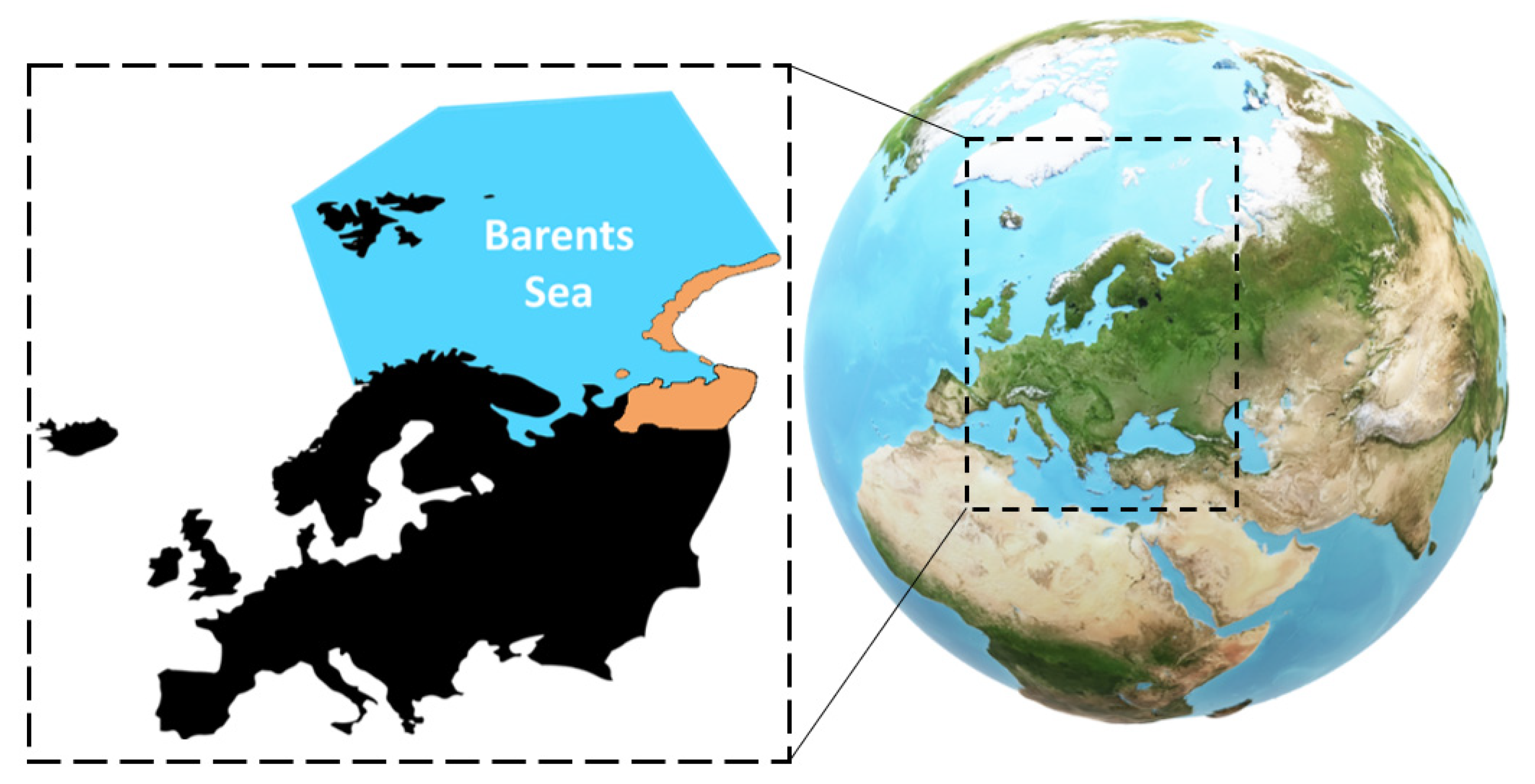
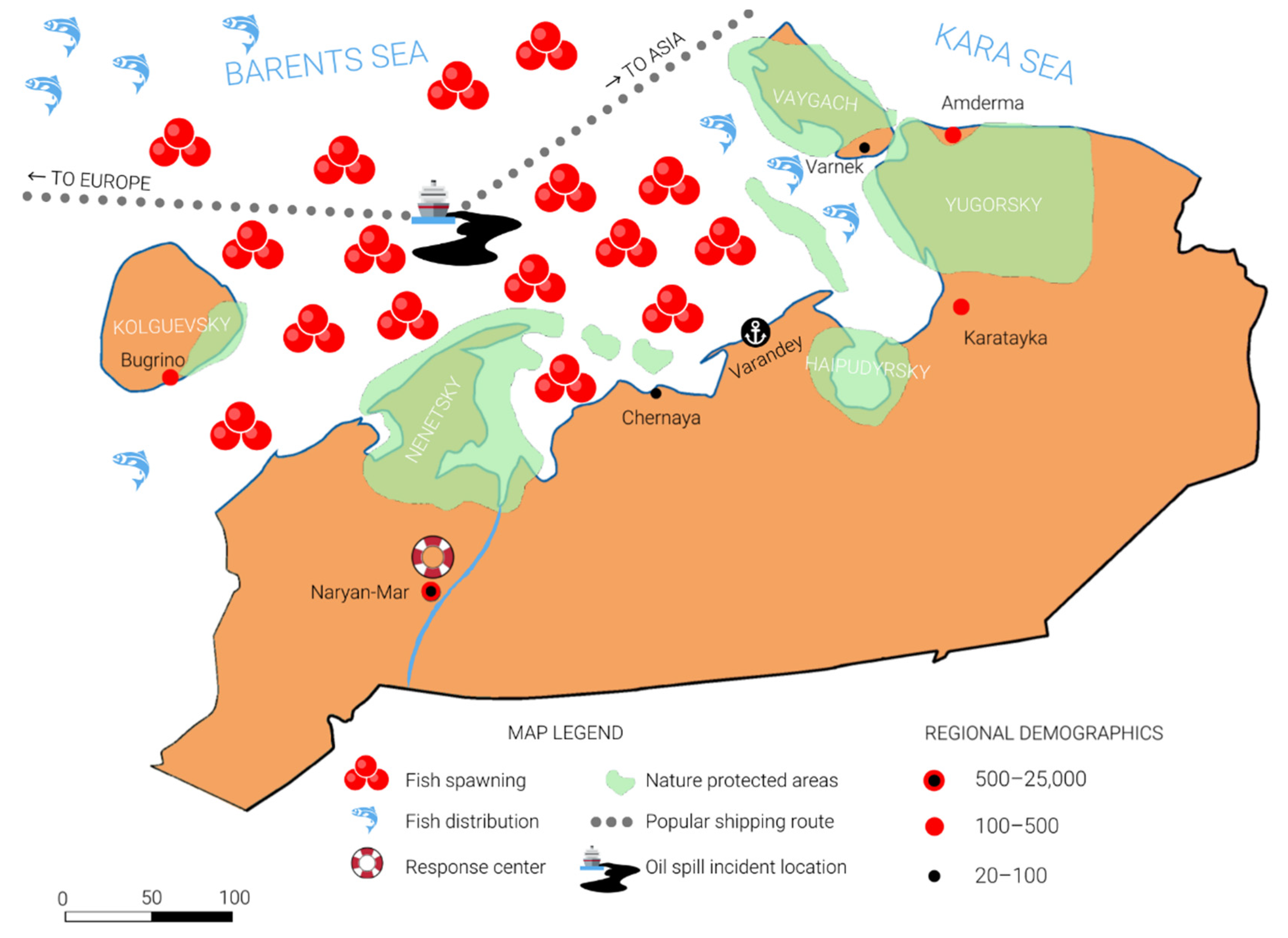
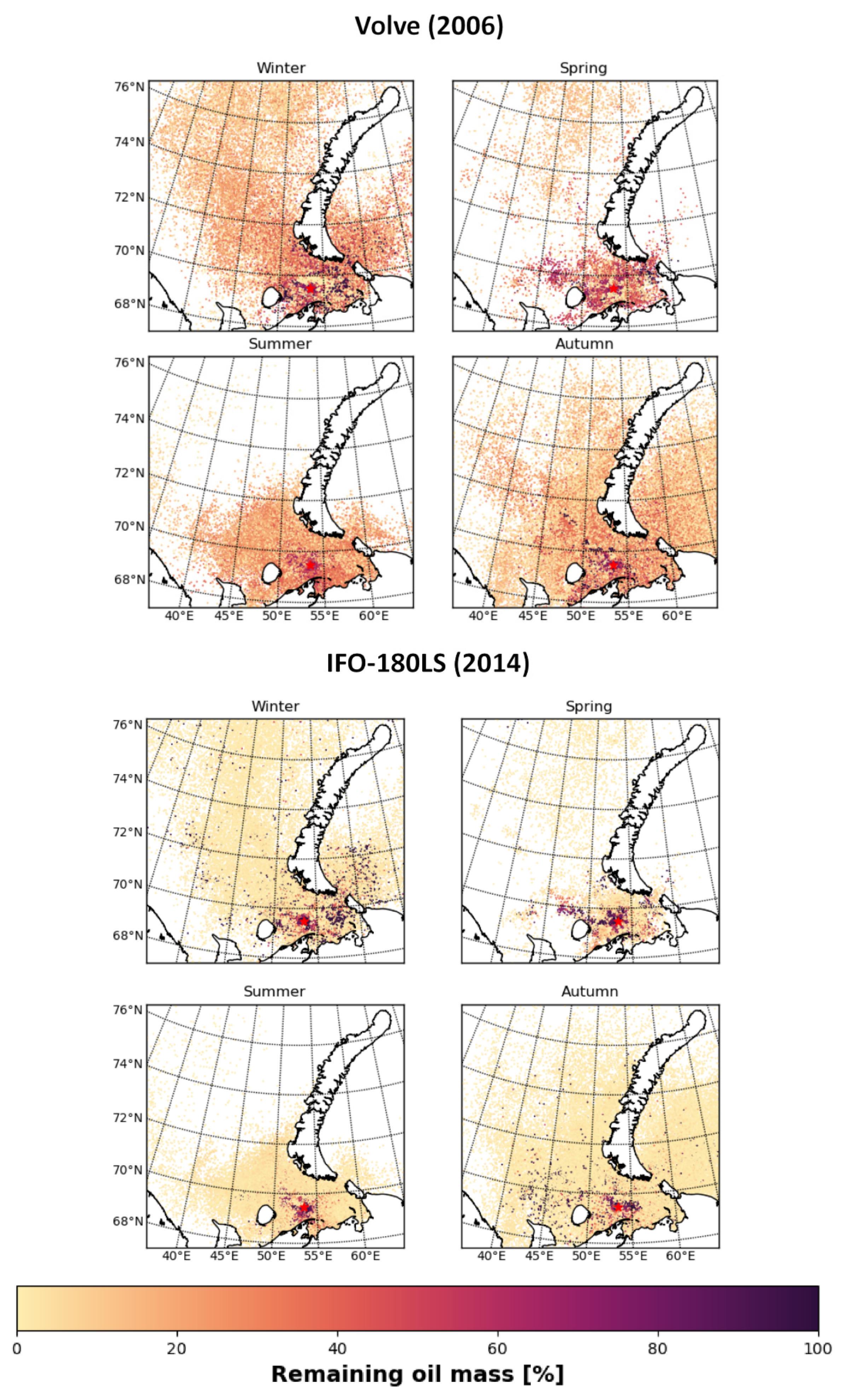
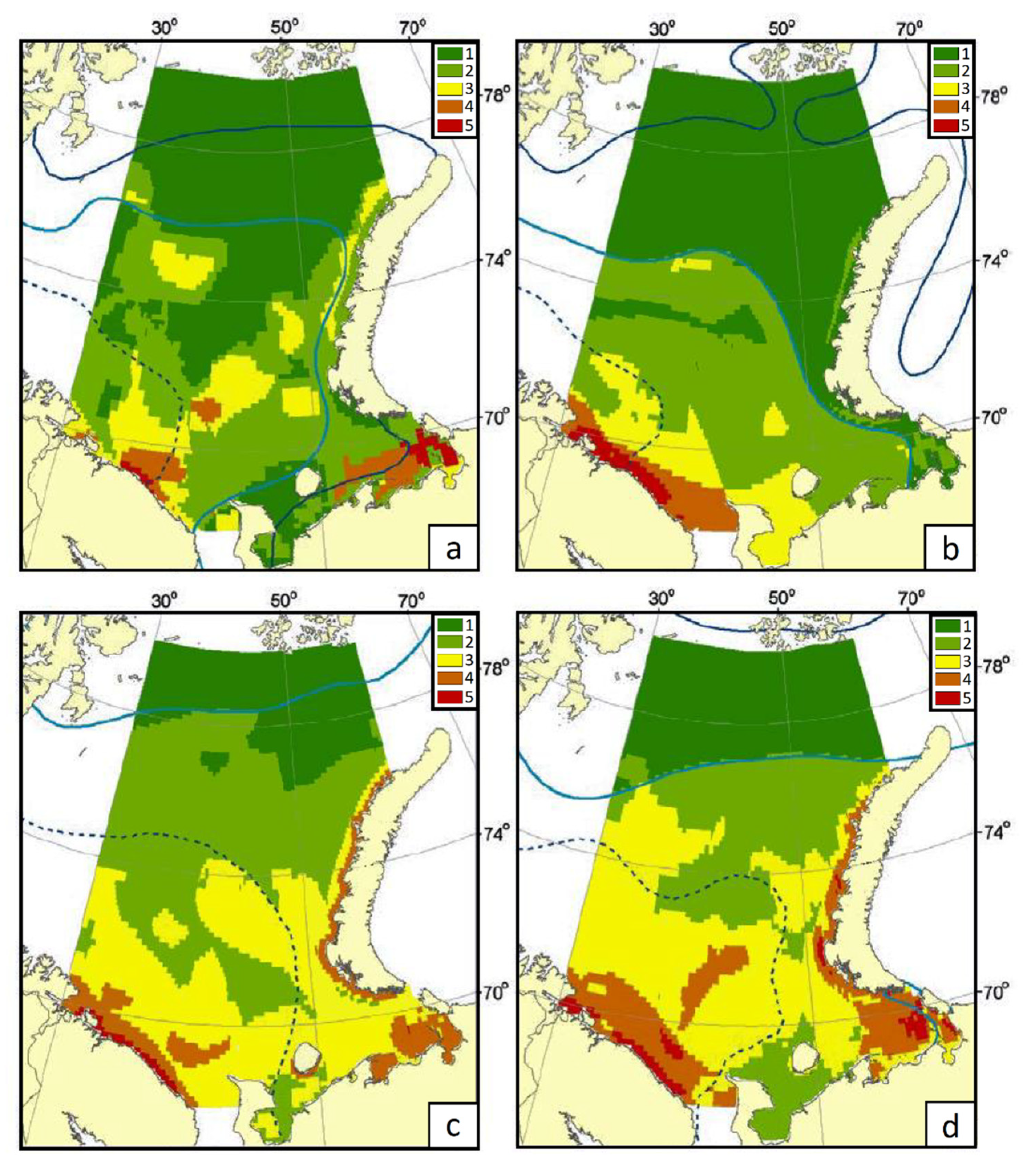
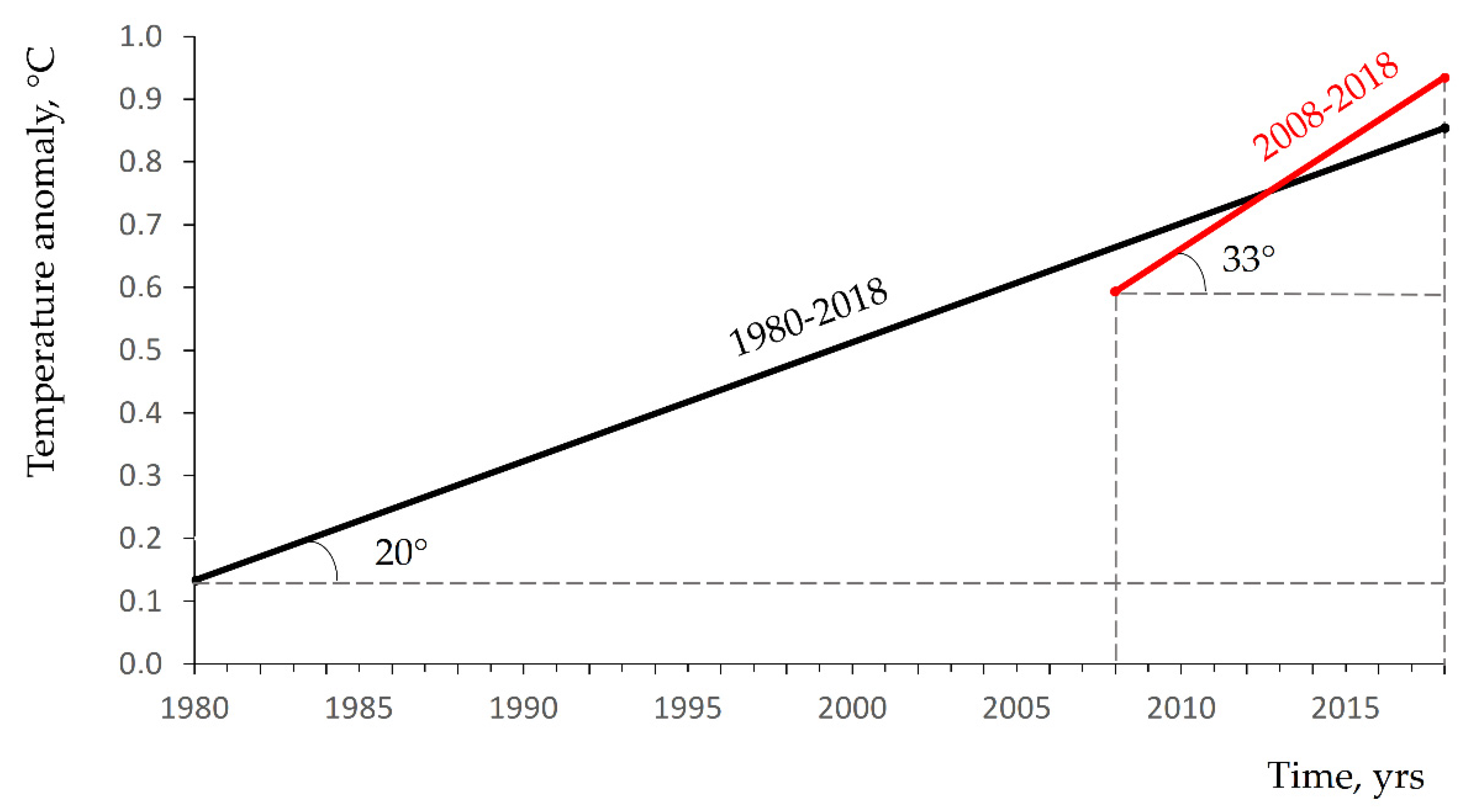
| Oil Category | API, ° | Oil Density (⍴), kg/m3 |
|---|---|---|
| Light | API ≥ 31.1 | ⍴ ≤ 870 |
| Medium | 22.3 ≤ API < 31.1 | 870 > ⍴ ≥ 920 |
| Heavy | 10 ≤ API < 22.3 | 920 > ⍴ ≥ 1000 |
| Extra-heavy | API < 10 | ⍴ > 1000 |
| OSR Tools | Seasonal OSR Operability, % | ||||||||||||
|---|---|---|---|---|---|---|---|---|---|---|---|---|---|
| Autumn | Winter | Spring | Summer | ||||||||||
| + | +/– | – | + | +/– | – | + | +/– | – | + | +/– | – | ||
| Dispersants | vessel application | 3 | 18 | 77 | 0 | 56 | 44 | 3 | 54 | 44 | 60 | 28 | 13 |
| helicopter application | 19 | 68 | 14 | 5 | 5 | 90 | 19 | 21 | 61 | 54 | 19 | 27 | |
| aircraft application | 9 | 58 | 34 | 0 | 6 | 94 | 3 | 21 | 77 | 10 | 47 | 44 | |
| Mechanical recovery | 3 vessels with boom | 20 | 75 | 6 | 0 | 6 | 94 | 2 | 10 | 89 | 19 | 25 | 56 |
| 2 vessels with boom | 27 | 12 | 61 | 0 | 37 | 63 | 3 | 34 | 63 | 58 | 28 | 14 | |
| 1 vessel with outrigger | 2 | 31 | 68 | 0 | 22 | 78 | 0 | 14 | 85 | 37 | 44 | 19 | |
| In situ burning | ignition from vessel | 5 | 55 | 40 | 0 | 26 | 74 | 2 | 27 | 71 | 20 | 56 | 24 |
| ignition from helicopter | 5 | 7 | 88 | 1 | 2 | 97 | 4 | 13 | 84 | 11 | 21 | 69 | |
Publisher’s Note: MDPI stays neutral with regard to jurisdictional claims in published maps and institutional affiliations. |
© 2021 by the authors. Licensee MDPI, Basel, Switzerland. This article is an open access article distributed under the terms and conditions of the Creative Commons Attribution (CC BY) license (https://creativecommons.org/licenses/by/4.0/).
Share and Cite
Pavlov, V.; Aguiar, V.C.M.d.; Hole, L.R.; Pongrácz, E. A 30-Year Probability Map for Oil Spill Trajectories in the Barents Sea to Assess Potential Environmental and Socio-Economic Threats. Resources 2022, 11, 1. https://doi.org/10.3390/resources11010001
Pavlov V, Aguiar VCMd, Hole LR, Pongrácz E. A 30-Year Probability Map for Oil Spill Trajectories in the Barents Sea to Assess Potential Environmental and Socio-Economic Threats. Resources. 2022; 11(1):1. https://doi.org/10.3390/resources11010001
Chicago/Turabian StylePavlov, Victor, Victor Cesar Martins de Aguiar, Lars Robert Hole, and Eva Pongrácz. 2022. "A 30-Year Probability Map for Oil Spill Trajectories in the Barents Sea to Assess Potential Environmental and Socio-Economic Threats" Resources 11, no. 1: 1. https://doi.org/10.3390/resources11010001
APA StylePavlov, V., Aguiar, V. C. M. d., Hole, L. R., & Pongrácz, E. (2022). A 30-Year Probability Map for Oil Spill Trajectories in the Barents Sea to Assess Potential Environmental and Socio-Economic Threats. Resources, 11(1), 1. https://doi.org/10.3390/resources11010001









